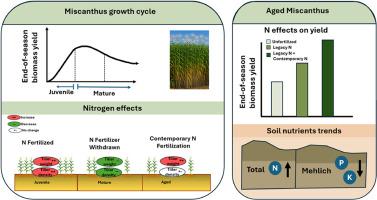可持续芒草生产的土壤肥力管理:氮肥管理增加分蘖重量解释了陈年芒草产量的增加
IF 5.8
2区 生物学
Q1 AGRICULTURAL ENGINEERING
引用次数: 0
摘要
芒草(Miscanthus x giganteus, Miscanthus)的衰老相关产量下降是制约其可持续生物量生产的主要因素。本研究评价了氮素管理和土壤肥力对老化芒草产量组成性状和生产力的影响。试验于2008年在伊利诺伊州厄巴纳的伊利诺伊大学能源农场建立的两个地点进行。(i) Sun Grant试验每年接收0,60和120 kg N ha - 1,直到2015年。从2021年开始,每个地块的一半接受60或120公斤N公顷- 1,产生六种传统当代处理:0N-0N, 0N-120N, 60N-0N, 60N-60N, 120N-0N, 120N-120N。(ii) Energy Farm试验直到2014年才开始施肥,每个地块的一半施肥56 kg N ha - 1,形成两种处理:0N-0N、0N-56N。Sun Grant试验结果表明,2011-2015年,施氮增加了芒草幼苗期至早熟期的分蘖密度(分蘖数m−2)和分蘖重(分蘖数g−1)。弃氮后,两项性状均下降(分别为20%和40%),但分蘖重在老化林分(2020-2023)中仍存在遗留效应。当代氮肥对分蘖密度影响不大,但使分蘖重增加34% ~ 77%,使0 ~ 120n、60 ~ 60n和120 ~ 120n地块的机采生物量产量提高23% ~ 106%。在Energy Farm试验中,0N-56N地块的生物量比0N-0N地块高出59% - 108%。土壤全氮增加(到2020年太阳补助金:47%;能源农场:到2023年58%),而mehlich - 3p(42% - 44%)和K(21% - 46%)下降。这些发现确定分蘖重量是老化芒草生物量产量的关键决定因素,并强调了对磷和钾进行长期生产力管理的必要性。本文章由计算机程序翻译,如有差异,请以英文原文为准。

Soil fertility management for sustainable Miscanthus × giganteus production: Increased tiller weight from nitrogen management explains yield gains in aged miscanthus
Aging-related yield decline in Miscanthus × giganteus (miscanthus) remains a major constraint to sustainable biomass production. This study evaluated how nitrogen (N) management and soil fertility influence yield-component traits and productivity in aging miscanthus. Trials were conducted at two sites established in 2008 at the University of Illinois Energy Farm, Urbana, IL. (i) The Sun Grant trial received 0, 60, and 120 kg N ha−1 annually until 2015. Starting 2021, half of each plot received 60 or 120 kg N ha−1, resulting in six legacy-contemporary treatments: 0N–0N, 0N–120N, 60N–0N, 60N–60N, 120N–0N, 120N–120N. (ii) The Energy Farm trial remained unfertilized until 2014, when one half of each plot received 56 kg N ha−1, forming two treatments: 0N–0N, 0N–56N. Sun Grant trial results showed N fertilization increased tiller density (tillers m−2) and tiller weight (g tiller−1) in juvenile to early-mature miscanthus (2011–2015). After N withdrawal, both traits declined (20 % and 40 %), though legacy effects persisted in tiller weight in the aging stands (2020–2023). Contemporary N had little effect on tiller density but increased tiller weight by 34 %–77 %, resulting in 23 %–106 % higher machine-harvested biomass yield in 0–120N, 60-60N, and 120-120N plots. At the Energy Farm trial, 0N–56N plots yielded 59 %–108 % more biomass than 0N–0N. Soil total N increased (Sun Grant: 47 % by 2020; Energy Farm: 58 % by 2023), while Mehlich-3 P (42 %–44 %) and K (21 %–46 %) declined. These findings identify tiller weight as a key determinant of biomass yield in aging miscanthus and highlight the need for P and K management for long-term productivity.
求助全文
通过发布文献求助,成功后即可免费获取论文全文。
去求助
来源期刊

Biomass & Bioenergy
工程技术-能源与燃料
CiteScore
11.50
自引率
3.30%
发文量
258
审稿时长
60 days
期刊介绍:
Biomass & Bioenergy is an international journal publishing original research papers and short communications, review articles and case studies on biological resources, chemical and biological processes, and biomass products for new renewable sources of energy and materials.
The scope of the journal extends to the environmental, management and economic aspects of biomass and bioenergy.
Key areas covered by the journal:
• Biomass: sources, energy crop production processes, genetic improvements, composition. Please note that research on these biomass subjects must be linked directly to bioenergy generation.
• Biological Residues: residues/rests from agricultural production, forestry and plantations (palm, sugar etc), processing industries, and municipal sources (MSW). Papers on the use of biomass residues through innovative processes/technological novelty and/or consideration of feedstock/system sustainability (or unsustainability) are welcomed. However waste treatment processes and pollution control or mitigation which are only tangentially related to bioenergy are not in the scope of the journal, as they are more suited to publications in the environmental arena. Papers that describe conventional waste streams (ie well described in existing literature) that do not empirically address ''new'' added value from the process are not suitable for submission to the journal.
• Bioenergy Processes: fermentations, thermochemical conversions, liquid and gaseous fuels, and petrochemical substitutes
• Bioenergy Utilization: direct combustion, gasification, electricity production, chemical processes, and by-product remediation
• Biomass and the Environment: carbon cycle, the net energy efficiency of bioenergy systems, assessment of sustainability, and biodiversity issues.
 求助内容:
求助内容: 应助结果提醒方式:
应助结果提醒方式:


